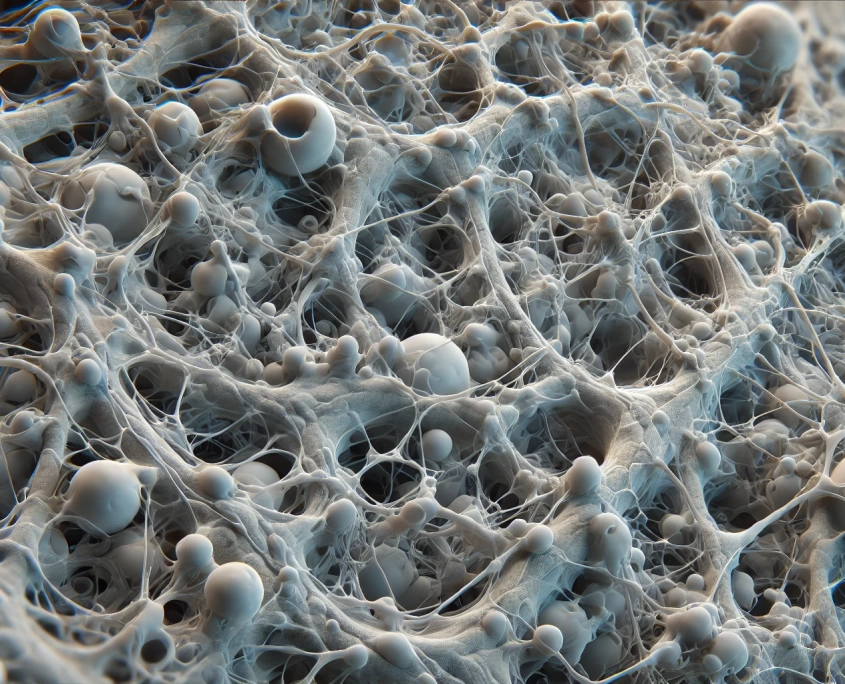RegeneVasc: Mechanisms of Action and the Role of the Endothelial Glycocalyx

RegeneVasc is a dietary supplement designed to support cardiovascular health by preserving, protecting, and regenerating the endothelial glycocalyx (eGCX).
The eGCX is a dense, gel-like meshwork covering the endothelial cell layer, playing a crucial role in maintaining vascular permeability, regulating blood flow, and protecting against cardiovascular diseases.
The endothelial glycocalyx is an essential component of the vascular system, serving as a protective barrier against mechanical stress and regulating vascular permeability. It is composed of glycosaminoglycans (GAGs), proteoglycans, and glycoproteins, which interact with circulating blood components to maintain homeostasis. Degradation of the eGCX is associated with various cardiovascular pathologies, including atherosclerosis, hypertension, and diabetes. RegeneVasc is formulated to provide the foundational building blocks necessary to regenerate this delicate barrier, promoting optimal cardiovascular health.
Ingredients and Mechanisms of Action:
-
Mobilee® Hyaluronic Acid Matrix:
- Source: Extracted from rooster comb, Mobilee® contains a high concentration of hyaluronic acid.
- Mechanism of Action: Hyaluronic acid is a key component of the eGCX, contributing to its structural integrity and function. It plays a central role in mechanosensing, which is essential for nitric oxide production and flow-induced vasodilation. Mobilee® has been shown to enhance the endogenous synthesis of hyaluronic acid, supporting the regeneration of the eGCX and improving vascular function.
-
Chondroitin Sulfate:
- Source: Derived from animal cartilage, chondroitin sulfate is the second most abundant GAG in the eGCX.
- Mechanism of Action: Chondroitin sulfate stimulates the synthesis of other GAGs, including heparan sulfate and hyaluronan, which are critical for the structural and functional integrity of the eGCX. It also exhibits anti-inflammatory properties by inhibiting the expression of TNF-α, IL-1β, IL-6, and COX-2, which are associated with vascular inflammation and cardiovascular diseases.
-
Maritech® Synergy (Fucus vesiculosus Seaweed Extract):
- Source: A proprietary blend of polyphenols and fucoidan from the brown seaweed Fucus vesiculosus.
- Mechanism of Action: Fucoidan and polyphenols from brown seaweed have potent antioxidant and anti-inflammatory properties. Fucoidan mimics the structure of heparan sulfate, a key GAG in the eGCX, and has been shown to directly interact with and protect the eGCX from degradation. Polyphenols, such as phlorotannins, act as electron traps for free radicals, reducing oxidative stress and supporting the regeneration of the eGCX.
The Role of the Endothelial Glycocalyx (eGCX): The eGCX is a critical structure in maintaining vascular homeostasis. It acts as a physical barrier that prevents the adhesion of leukocytes and platelets to the endothelial surface, thus reducing the risk of atherosclerosis. The eGCX also plays a role in mechanotransduction, where it senses and responds to changes in blood flow, facilitating the production of nitric oxide, a potent vasodilator. Degradation of the eGCX leads to increased vascular permeability, inflammation, and the development of cardiovascular diseases.
RegeneVasc provides a comprehensive approach to cardiovascular health by targeting the endothelial glycocalyx, a crucial component of the vascular system.
The combination of Mobilee® hyaluronic acid, chondroitin sulfate, and Maritech® Synergy offers a multifaceted mechanism of action that supports the regeneration and protection of the eGCX.
By preserving the integrity of the eGCX, RegeneVasc helps maintain optimal circulation, blood flow, and vascular health.
References:
- Becker BF, Jacob M, Leipert S, Salmon AH, Chappell D. Degradation of the endothelial glycocalyx in clinical settings: searching for the sheddases. Br J Clin Pharmacol. 2015;80(3):389-402.
- Villalba N, Baby S, Yuan SY. The Endothelial Glycocalyx as a Double-Edged Sword in Microvascular Homeostasis and Pathogenesis. Front Cell Dev Biol. 2021;9:711003.
- Machin DR, Bloom SI, Campbell RA, et al. Advanced age results in a diminished endothelial glycocalyx. Am J Physiol Heart Circ Physiol. 2018;315(3)
. - Qi F, Zhou H, Gu P, et al. Endothelial glycocalyx degradation is associated with early organ impairment in polytrauma patients. BMC Emerg Med. 2021;21(1):52.
- Keleszade E, Patterson M, Trangmar S, Guinan KJ, Costabile A. Clinical Efficacy of Brown Seaweeds Ascophyllum nodosum and Fucus vesiculosus in the Prevention or Delay Progression of the Metabolic Syndrome: A Review of Clinical Trials. Molecules. 2021;26(3):714.
- Patankar MS, Oehninger S, Barnett T, Williams RL, Clark GF. A revised structure for fucoidan may explain some of its biological activities. J Biol Chem. 1993;268(29):21770-21776.
- Kim AR, Shin TS, Lee MS, et al. Isolation and identification of phlorotannins from Ecklonia stolonifera with antioxidant and anti-inflammatory properties. J Agric Food Chem. 2009;57(9):3483-3489.
- Li Y, Lee SH, Lee QT, Kim MM, Kim SK. Anti-allergic effects of phlorotannins on histamine release via binding inhibition between IgE and Fc epsilonRI. J Agric Food Chem. 2008;56(24):12073-12080.
- Ahn MJ, Yoon KD, Min SY, et al. Inhibition of HIV-1 reverse transcriptase and protease by phlorotannins from the brown alga Ecklonia cava. Biol Pharm Bull. 2004;27(4):544-547.
- Gabbia D, Saponaro M, Sarcognato S, et al. Fucus vesiculosus and Ascophyllum nodosum Ameliorate Liver Function by Reducing Diet-Induced Steatosis in Rats. Mar Drugs. 2020;18(1):62.
- Marinval N, Saboural P, Haddad O, et al. Identification of a Pro-Angiogenic Potential and Cellular Uptake Mechanism of a LMW Highly Sulfated Fraction of Fucoidan from Ascophyllum nodosum. Mar Drugs. 2016;14(10):185.
